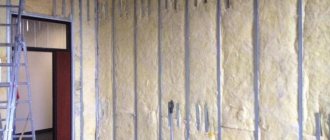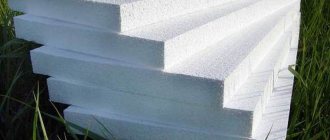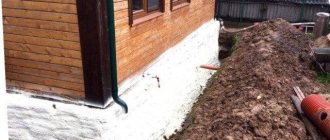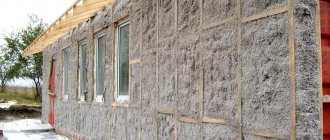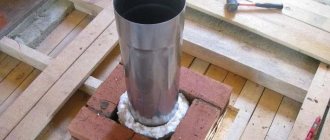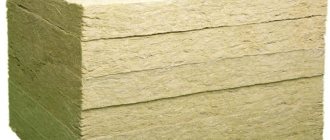When wanting to insulate a home, the question often arises: which is better, polyurethane foam or mineral wool. The second option is popular due to its low cost and availability. It is one of the most popular building materials. Polyurethane foam is not so popular, but its characteristics are at a high level. PPU is gradually taking the lead. Let's look at why this happens.
Insulation materials
Mineral wool: pros and cons
Mineral wool is a heat-insulating building material characterized by its fibrous structure. Its production is based on the processing of mineral raw materials extracted from the bowels of the earth. Additionally, synthetic binding fibers are introduced into the insulation composition.
Mineral wool
Mineral insulation is divided into:
- basalt;
- slag;
- glass
The positive qualities of mineral raw materials include:
- low degree of thermal conductivity of insulation. High thermal insulation characteristics and efficiency are observed;
- soundproofing properties of the material. The porous structure allows the use of thermal insulation to absorb noise from outside the house. The best option for residents of megacities;
- fire resistance. Mineral thermal insulation is not subject to fire. Can be used for insulation of flammable buildings;
- vapor permeability. The breathable structure of the insulating material allows the walls to “breathe”. This is important for the thermal insulation of a wooden structure. Air exchange will extend the life of a capital structure;
- ease and simplicity of installation work. No specialized education required. After studying the technology, you are allowed to take on insulating the house yourself;
- mineral wool is a biologically neutral material. It is not subject to rotting and attack by insects and rodents. Mold and mildew do not form on the surface;
- low pricing policy allows you to use mineral wool without obstacles;
- resistance to deformation and elasticity;
- long service life of building materials.
The disadvantages of mineral wool include:
- hygroscopicity. By absorbing moisture and getting wet, the material loses its quality. It is recommended to use high-quality waterproofing of walls;
- When temperatures reach above 300 degrees Celsius above zero, mineral wool evaporates dangerous toxic substances into the air. Under normal conditions this does not happen.
Agriculture and catering
PIR panels do not accumulate moisture, are not susceptible to the harmful effects of rodents and insects, and are biologically stable, which is especially important for the agricultural sector. At the same time, according to hygienic standards, polyurethane foam is allowed to be used in refrigeration equipment for food products. True, some experts still recommend using mineral wool insulation for public catering establishments, because these buildings require increased fire safety and only non-combustible materials should be used there.
Polyurethane foam: pros and cons
The advantages of polyurethane foam include:
- tendency to “stick” to the materials from which the walls are made: brick, glass, concrete and metal surfaces. The shape of the wall and the presence of bulges do not matter. Good adhesion of the insulation allows you to avoid installing a mounting frame;
- polyurethane foam is made directly at the site of insulation. Transportation costs are minimized. Material costs for insulation are minimal;
- The insulation is extremely light. No surface heaviness is observed. Used for roof thermal insulation;
- polyurethane foam not only insulates the surface, it adds strength and reliability to them;
- the material is not afraid of high and low temperatures, or their sudden changes. Maintains the specified technical and operational parameters at temperatures of +200 - -200 degrees Celsius;
- no costs for vapor barrier, installation of a metal frame, counter slats, wind protection;
- The polyurethane foam coating simultaneously provides waterproofing of the surface. The structure is protected from the negative effects of moisture and water. The service life of the home increases;
- A distinctive feature of the insulation is its seamlessness. The surface is covered with thermal insulation without a single joint or seam. A solid fabric is formed, tightly fitting the structure.
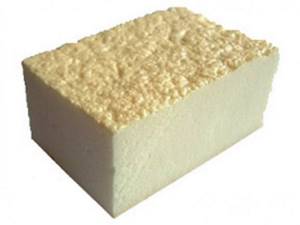
The disadvantages of building coatings include:
- negative effect of ultraviolet radiation on insulation. Under its influence, the thermal insulation coating is destroyed faster. It is important to organize high-quality protection of the coating from ultraviolet radiation. Suitable for painting, plastering, installing panels and other types of finishing of the building facade. This will protect the polyurethane foam from destruction and make the structure aesthetically attractive;
- polyurethane foam belongs to the thermal insulation of the second flammability group. It does not ignite, but begins to smolder. This stops as soon as the surface is cooled. But it is not recommended to use insulation for cladding flammable buildings.
Basic properties of polyurethane foam
– density: 40 – 160 kg/m;
– thermal conductivity: 0.019-0.025 W/m*K; – operating temperature range: -180…+180 оС;
– effective service life: 30 years. Polyurethane foam has low hygroscopicity, so it does not require additional insulation. It is this property that provides it with a service life comparable to the service life of ondulin.
PPU does not require any fastening, compensates for all unevenness and can be used on any type of roof. When sprayed, polyurethane foam hermetically seals all cracks, which eliminates the appearance of cold bridges. Polyurethane foam is more expensive than mineral wool, but this disadvantage is fully compensated for:
– with equal characteristics, the polyurethane foam layer is 3 times thinner than mineral wool; – spraying polyurethane foam is 10 times faster than laying inorganic insulation;
– the costs of delivering polyurethane foam are significantly lower; – PPU does not require maintenance or replacement during the entire service life of the ondulin roof.
Polyurethane foam is environmentally friendly, absolutely safe for humans and does not require careful insulation, however, spraying must be done using personal protective equipment. Both materials have their advantages and disadvantages. We hope this article will help you make the right choice.
Old thermal insulation materials are being replaced by new materials, like polyurethane foam replacing mineral wool. Despite the fact that the disadvantages of mineral wool are obvious, it continues to be used as insulation, as it is believed to be cheap and accessible. Let's look into these statements.
Differences in the characteristics of mineral wool and polyurethane foam
Distinctive parameters of insulating building materials:
- thermal insulation qualities. Polyurethane foam as a spray creates a solid insulation sheet, without cracks or joints. Heat loss from the home is virtually eliminated. Mineral wool is not free from the formation of “cold bridges” through which heat escapes;
- toxicity. Polyurethane foam is non-toxic. Not flammable. Does not emit dangerous poisons into the atmosphere. Allowed for use in rooms with a high level of fire hazard. Although mineral wool is non-toxic, at high temperatures it emits toxic vapor that is dangerous to humans. She is smoldering. Not recommended for use in flammable areas;
- quality and speed of insulation installation. Cotton wool is produced in sheets. Laying requires the creation of lathing for additional fixation and cutting of the material. PPU in the form of a spray insulates the facade of the house quickly and efficiently;
- transportation. Although the cotton wool is light in weight, it is large in size. Takes up a lot of space. PPU is made directly at the point of use. Presented in the form of a small bottle. Doesn't take up much space;
- When working with cotton wool and polyurethane foam, it is recommended to use eye and respiratory protection and wear a protective suit;
- The cost of mineral wool is significantly cheaper, but if you compare how much money is required to transport it and how much scraps are left, then overall the difference is not great. Cotton wool consumption is 20-30% more than polyurethane foam. Plus, it is necessary to additionally provide vapor and waterproofing. Especially if you take into account the safety of the insulation - polyurethane foam;
- Vata is divided into several varieties. Various insulation options are used for walls, roofs and ceilings. PPU is universal. It is used in one variation for the entire home. There is no need to purchase different types of products. The task of insulating the house is simplified;
- polyurethane foam sprayer makes it easier to create the required insulation thickness. Cotton wool is purchased in the required size. It is difficult to change the thickness of the insulation on site. Is it possible to fold it in half?
- durability. The manufacturer indicates 50 years of service life for insulating materials. In practice, in just a couple of years, the material loses its thermal insulation qualities by 40%. The feasibility of using an insulating coating is 2-3 years. Polyurethane foam shows the best results, provided that reliable protection of the coating from ultraviolet radiation is provided. Otherwise, the material is not afraid of anything.
Lightweight material and wide application
Polyurethane foam is lighter than mineral wool. As the leading design engineer Vitaly Viktorov
, the density of mineral wool in sandwich panels is more than 100 kg/cu.m. meter, and the PIR density is only 40 kg / cubic meter. meter, that is, PIR is more than twice as light. This means that installing it is twice as easy. In addition, the thermal conductivity coefficient of polyurethane foam is two times lower than that of mineral wool. Thus, for equal insulation, you will need a layer of mineral wool twice as thick as a layer of polyurethane foam.

Cottage insulated using sandwich panels made of polyurethane foam. Photo source: NAPPAN
Dmitry Lappo, deputy managing director of Perspektiva Insurance Company.
. At the same time, the insulation of enclosing structures using the spraying method is a homogeneous continuous mass without seams or cold bridges, and the use of mechanical fastening of the insulation is not required. In addition, polyurethane insulation in cylinders can be used to seal leaks in hard-to-reach places (leaks in walls, ceilings), comments Sergey Plotnikov. Polymer insulation finds its area of application in the construction of cold warehouses with freezers, in road construction, and in structures with significant loads, says Andrey Petrov.
Areas of use
Areas of use of mineral insulation - wool:
- thermal insulation of the surface of walls and ceilings in the bathhouse;
- internal thermal insulation of enclosing structures in any position for all permanent buildings;
- insulation of ventilated facades of hinged type;
- thermal insulation of wet facade systems;
- insulation of industrial devices, networks and highways;
- improving the heat and sound insulation of the roof.

Polyurethane foam is actively used not only in the construction, but also in the automotive, light, furniture and footwear industries. It is used as a filler for children's soft toys. The raw materials are environmentally safe and harmless to the human body of adults and children.
Scope of application of polyurethane foam in construction:
- thermal insulation of main pipes and low-temperature pipelines of the chemical industry;
- insulation of industrial and civil buildings;
- hydro- and thermal insulation of the foundation;
- roof insulation.
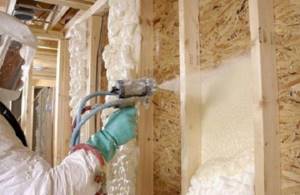
Insulation with polyurethane foam
Combustible and non-flammable insulation
Insulation materials are flammable and non-flammable. Non-flammable - these are basalt, made of mineral wool: brands RUF N30, N60, Axi RUF, PPZh. Combustible insulation materials : polystyrene foam, penoplex, polyurethane foam. If you ask an ordinary person which thermal insulator is preferable, the majority will answer “non-flammable.” But this is the wrong answer if it is insulation that is needed, and not a fire retardant compound. You're not going to burn it, are you?
Please note that most terrible fires are caused by pyrotechnics and open fires in a residential building. And, almost always, polystyrene foam is used as insulation. It is usually called simply foam. But this is wrong, because... “foam” is the definition of the entire group of gas-filled plastics. Meanwhile, polyurethane foam, although it is a type of polystyrene foam, burns much worse than polystyrene foam. Some brands of polyurethane foam are generally classified as low-flammable. Expanded polystyrene is chosen because of price (it is cheaper) or because of misunderstanding (they think that all insulation is the same). Both are wrong. If you are building a house for yourself, then you don’t even need to think much to choose polystyrene foam or polyurethane foam. By the way, did you know that polyurethanes and polyurethane foams are used in military affairs? For example, as an element of semi-active protection. Cellular armor consists of a set of cavities filled with a quasi-liquid substance (polyurethane). This is a development of the Institute of Hydrodynamics of the Siberian Branch of the USSR Academy of Sciences. This protection is installed on the T-72B, T-80U and T-80UD tanks. Or, for example, the American M765 infantry fighting vehicle has two hulls. The main capsule, around which light multi-layer armor is attached along the sides and stern. The space between the main and multi-layer armor is filled with polyurethane foam to ensure better buoyancy. The tower is also additionally protected by multi-layer armor, respectively, and polyurethane foam. In addition to buoyancy, the advantage of this design is that polyurethane foam is thermal insulation, i.e. in such a combat vehicle it is not cold in winter and not hot in summer. Naturally, if there was a risk of polyurethane foam catching fire (they generally fire at infantry fighting vehicles, including incendiary and shaped charges), then the Americans would not use it to fill the voids between the two bodies of the combat vehicle. Therefore, the question about the flammability of polyurethane foam cannot be answered unambiguously. About mineral wool, yes, we can say that it is non-flammable. But nothing is known about the experience of using it in military affairs to protect tanks and infantry fighting vehicles under enemy fire. If we compare whether mineral wool or polyurethane foam is better, then polyurethane foam, as an insulation material, is superior to mineral wool.
Which insulation is better?
The construction industry presents a wide range of popular materials that can retain heat inside the house. These are polyurethane foam, mineral wool, polystyrene foam and much more. Their differences lie in the type of manufacture, environmental safety, period of operation, efficiency, nature of installation, and cost. The main thing is to choose the insulation that is suitable for a particular case. There are no low-quality materials, there is thermal insulation that is poorly suited to a particular situation.
If we compare mineral wool and polyurethane foam, the second option is superior in all areas. It has been more effective in heating a home for decades. Thanks to the solid structure and spraying, there are no gaps through which heat is lost. Polyurethane foam insulation is practical and safe. Ideal for insulating a private home.
Mineral building wool and polyurethane foam have many positive and negative qualities. What type of insulation to use depends on the specific case and purpose of the building. The choice rests with the owner of the house.
On the issue of wet areas
Polyurethane foam has low water absorption - up to 2% of the total mass, which allows the use of slabs or panels in rooms with high humidity. In addition, polyurethane foam is chemically neutral to acidic and alkaline environments and is biologically stable. Due to the fact that it does not absorb moisture, mold does not develop. True, Dmitry Lappo notes that polyurethane foam insulation has very low vapor permeability, which can negatively affect the microclimate in the room, creating a greenhouse effect.
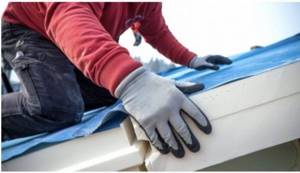
Installation of PIR panels on the roof. Photo source: rcmm.ru
At the same time, when moistened, mineral wool insulation significantly loses its thermal properties, comments Vitaly Viktorov. Mineral wool can absorb water, which transfers heat or cold much better and, moreover, when frozen, turns into ice and can damage the integrity of the structure. When moisture penetrates deeply, the mineral wool sticks together, the fibers stick together, and the material loses its strength. When working with stone wool in wet areas - a bathroom or toilet - it is important to provide a vapor barrier membrane, emphasizes Konstantin Kozetov
. Typically, stone wool in these rooms is installed in the partitions to soundproof the bathroom area from the room.
Flammability
Ecowool and mineral wool belong to the flammability group G1 (low-flammable materials), and polyurethane foam belongs to groups G2-G4 (from moderately flammable to highly flammable), depending on the composition of the mixture. The self-ignition temperature of polyurethane foam is 650°C, ignition temperature is 345°C. Ecowool does not ignite at temperatures up to 1200°C, and some types of mineral wool can withstand temperatures up to 1000°C. Accordingly, in comparison of polyurethane foam and ecowool, polyurethane foam is intended for use at lower temperatures. However, if a fire does occur, the fumes from polyurethane foam are much less harmful to health than the compounds emitted by mineral wool.
Adhesion and installation features
Adhesion is the ability of a material to “stick” to the application surface. The more tightly the material “grabs” to the surface, the better the thermal insulation. Ecowool, polyurethane foam and mineral wool have good adhesion to vertical surfaces (walls). However, for installing thermal insulation on ceilings and other horizontal surfaces, the adhesive substance contained in mineral wool and ecowool is not enough, while polyurethane foam adheres perfectly to any surface.
Advice from a professional
There are two main types of exterior finishing of walls insulated with polyurethane foam - siding and plaster. Each method has its own subtleties of applying polyurethane foam, which are important to know in advance for proper preparation of surfaces and subsequent finishing.
Environmental friendliness
According to the results of recent studies, mineral wool emits carcinogenic dust, which can accumulate in the lungs and cause irritation of internal tissues, mucous membranes, skin, and gastrointestinal tract. In addition, mineral wool contains phenol-formaldehyde resins, which release toxic formaldehydes and phenols. When choosing between polyurethane foam and mineral wool, it is worth considering the potential health hazards. Polyurethane foam in its hardened form does not pose any danger to the human body throughout its entire service life, subject to certain installation and operation rules.
